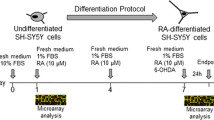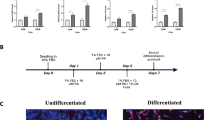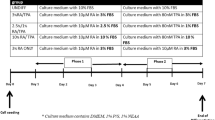Abstract
Human neuroblastoma SH-SY5Y cells have been used as an in vitro model for neurodegenerative disorders such as Parkinson’s disease and can be induced to a mature neuronal phenotype through retinoic acid (RA) differentiation. However, mechanisms of RA-induced differentiation remain unclear. Here, we investigate the role of reactive species (RS) on SH-SY5Y neuroblastoma cells under RA differentiation, using the antioxidant Trolox® as co-treatment. We found that RA treatment for 7 days reduced the cell number and proliferative capacity and induced the expression of adult catecholaminergic/neuronal markers such as tyrosine hydroxylase (TH), β-III tubulin, and enolase-2. Evaluation of intracellular RS production by DCFH oxidation assay and quantification of cell non-enzymatic antioxidant activity by TRAP demonstrated that RA increases RS production. Furthermore, mitochondrial NADH oxidation showed to be inhibited under differentiation with RA. Cells subjected to co-treatment with antioxidant Trolox® demonstrated a remaining proliferative capacity and a decrease in the pro-oxidant state and RS production. Besides, antioxidant treatment restores the mitochondrial NADH oxidation. Importantly, Trolox® co-treatment inhibited the appearance of morphological characteristics such as neurite extension and branching, and decreased the expression of TH, β-III tubulin, and enolase-2 after a seven-day differentiation with RA, indicating that RS production is a necessary step in this process. Trolox® also inhibited the phosphorylation of Akt and ERK1/2, which are involved in differentiation and survival, respectively, of these cells. Altogether, these data indicate the presence of a redox-dependent mechanism in SH-SY5Y RA-differentiation process and can be a useful insight to improve understanding of neuronal differentiation signaling.






Similar content being viewed by others
References
Alberio T, Lopiano L, Fasano M (2012) Cellular models to investigate biochemical pathways in Parkinson’s disease. FEBS J 279(7):1146–1155. doi:10.1111/j.1742-4658.2012.08516.x
Hattori N, Wanga M, Taka H, Fujimura T, Yoritaka A, Kubo S, Mochizuki H (2009) Toxic effects of dopamine metabolism in Parkinson’s disease. Parkinsonism and Related Disorders 15:S35–S38
Agholme L, Lindstrom T, Kagedal K, Marcusson J, Hallbeck M (2010) An in vitro model for neuroscience: differentiation of SH-SY5Y cells into cells with morphological and biochemical characteristics of mature neurons. Journal of Alzheimer’s disease: JAD 20(4):1069–1082
Encinas M, Iglesias M, Liu Y, Wang H, Muhaisen A, Ceña V, Gallego C, Comella JX (2000) Sequential treatment of SH-SY5Y cells with retinoic acid and brain-derived neurotrophic factor gives rise to fully differentiated, neurotrophic factor-dependent, human neuron-like cells. J Neurochem 75(3):991–1003
Filograna R, Civiero L, Ferrari V, Codolo G, Greggio E, Bubacco L, Beltramini M, Bisaglia M (2015) Analysis of the catecholaminergic phenotype in human SH-SY5Y and BE(2)-M17 neuroblastoma cell lines upon differentiation. PLoS One 10(8):e0136769. doi:10.1371/journal.pone.0136769
Korecka JA, van Kesteren RE, Blaas E, Spitzer SO, Kamstra JH, Smit AB, Swaab DF, Verhaagen J et al (2013) Phenotypic characterization of retinoic acid differentiated SH-SY5Y cells by transcriptional profiling. PLoS One 8(5):e63862. doi:10.1371/journal.pone.0063862
Maden M (2007) Retinoic acid in the development, regeneration and maintenance of the nervous system. Nat Rev Neurosci 8(10):755–765. doi:10.1038/nrn2212
Cheung YT, Lau WK, Yu MS, Lai CS, Yeung SC, So KF, Chang RC (2009) Effects of all-trans-retinoic acid on human SH-SY5Y neuroblastoma as in vitro model in neurotoxicity research. Neurotoxicology 30(1):127–135. doi:10.1016/j.neuro.2008.11.001
Miloso M, Villa D, Crimi M, Galbiati S, Donzelli E, Nicolini G, Tredici G (2004) Retinoic acid-induced neuritogenesis of human neuroblastoma SH-SY5Y cells is ERK independent and PKC dependent. J Neurosci Res 75:241–252
Qiao J, Paul P, Lee S, Qiao L, Josifi E, Tiao JR, Chung DH (2012) PI3K/AKT and ERK regulate retinoic acid-induced neuroblastoma cellular differentiation. Biochem Biophys Res Commun 424(3):421–426. doi:10.1016/j.bbrc.2012.06.125
Masia S, Alvarez S, de Lera AR, Barettino D (2007) Rapid, nongenomic actions of retinoic acid on phosphatidylinositol-3-kinase signaling pathway mediated by the retinoic acid receptor. Mol Endocrinol 21(10):2391–2402
Li W, Chen S, Li JY (2015) Human induced pluripotent stem cells in Parkinson’s disease: a novel cell source of cell therapy and disease modeling. Prog Neurobiol. doi:10.1016/j.pneurobio.2015.09.009
Klamt F, Dal-Pizzol F, Roehrs R, de Oliveira RB, Dalmolin R, Henriques JAP, de Andrades HHR, de Paula Ramos ALL et al (2003) Genotoxicity, recombinogenicity and cellular preneoplasic transformation induced by vitamin a supplementation. Mutation Research/Genetic Toxicology and Environmental Mutagenesis 539(1–2):117–125. doi:10.1016/s1383-5718(03)00155-4
Gelain DP, Moreira JC (2008) Evidence of increased reactive species formation by retinol, but not retinoic acid, in PC12 cells. Toxicology in vitro: an international journal published in association with BIBRA 22(3):553–558. doi:10.1016/j.tiv.2007.11.007
Zanotto-Filho A, Cammarota M, Gelain DP, Oliveira RB, Delgado-Canedo A, Dalmolin RJ, Pasquali MA, Moreira JC (2008) Retinoic acid induces apoptosis by a non-classical mechanism of ERK1/2 activation. Toxicology in vitro: an international journal published in association with BIBRA 22(5):1205–1212. doi:10.1016/j.tiv.2008.04.001
Pasquali MA, Gelain DP, Zanotto-Filho A, de Souza LF, de Oliveira RB, Klamt F, Moreira JC (2008) Retinol and retinoic acid modulate catalase activity in Sertoli cells by distinct and gene expression-independent mechanisms. Toxicology in vitro: an international journal published in association with BIBRA 22(5):1177–1183. doi:10.1016/j.tiv.2008.03.007
Klamt F, Dal-Pizzol F, Roehrs R, de Oliveira RB, Dalmolin R, Henriques JA, de Andrades HH, de Paula Ramos AL et al (2003) Genotoxicity, recombinogenicity and cellular preneoplasic transformation induced by vitamin A supplementation. Mutat Res 539(1–2):117–125
Dal-Pizzol F, Klamt F, Dalmolin RJ, Bernard EA, Moreira JC (2001) Mitogenic signaling mediated by oxidants in retinol treated Sertoli cells. Free Radic Res 35(6):749–755
Gelain DP, Cammarota M, Zanotto-Filho A Jr, de Oliveira RB, Dal-Pizzol F, Izquierdo I, Bevilaqua LRM, Moreira JC (2006) Retinol induces the ERK1/2-dependent phosphorylation of CREB through a pathway involving the generation of reactive oxygen species in cultured Sertoli cells. Cell Signal 18(10):1685–1694. doi:10.1016/j.cellsig.2006.01.008
Moreira JC, Dal-Pizzol F, Rocha AB, Klamt F, Ribeiro NC, Ferreira CJ, Bernard EA (2000) Retinol-induced changes in the phosphorylation levels of histones and high mobility group proteins from Sertoli cells. Brazilian journal of medical and biological research = Revista brasileira de pesquisas medicas e biologicas/Sociedade Brasileira de Biofisica [et al] 33(3):287–293
Gelain DP, Moreira JC, Bevilaqua LR, Dickson PW, Dunkley PR (2007) Retinol activates tyrosine hydroxylase acutely by increasing the phosphorylation of serine40 and then serine31 in bovine adrenal chromaffin cells. J Neurochem 103(6):2369–2379. doi:10.1111/j.1471-4159.2007.04935.x
de Bittencourt Pasquali MA, de Ramos VM, Albanus RD, Kunzler A, de Souza LH, Dalmolin RJ, Gelain DP, Ribeiro L et al (2014) Gene expression profile of NF-kappaB, Nrf2, glycolytic, and p53 pathways during the SH-SY5Y neuronal differentiation mediated by retinoic acid. Mol Neurobiol. doi:10.1007/s12035-014-8998-9
Schneider L, Giordano S, Zelickson BR, Johnson MS, Benavides GA, Ouyang X, Fineberg N, Darley-Usmar VM et al (2011) Differentiation of SH-SY5Y cells to a neuronal phenotype changes cellular bioenergetics and the response to oxidative stress. Free Radic Biol Med 51(11):2007–2017. doi:10.1016/j.freeradbiomed.2011.08.030
Zhao F, Wu T, Lau A, Jiang T, Huang Z, Wang XJ, Chen W, Wong PK et al (2009) Nrf2 promotes neuronal cell differentiation. Free Radic Biol Med 47(6):867–879. doi:10.1016/j.freeradbiomed.2009.06.029
Nitti M, Furfaro AL, Cevasco C, Traverso N, Marinari UM, Pronzato MA, Domenicotti C (2010) PKC delta and NADPH oxidase in retinoic acid-induced neuroblastoma cell differentiation. Cell Signal 22(5):828–835. doi:10.1016/j.cellsig.2010.01.007
Vichai V, Kirtikara K (2006) Sulforhodamine B colorimetric assay for cytotoxicity screening. Nat Protoc 1(3):1112–1116. doi:10.1038/nprot.2006.179
Rabelo TK, Zeidan-Chulia F, Vasques LM, dos Santos JP, da Rocha RF, Pasquali MA, Rybarczyk-Filho JL, Araujo AA et al (2012) Redox characterization of usnic acid and its cytotoxic effect on human neuron-like cells (SH-SY5Y). Toxicology in vitro: an international journal published in association with BIBRA 26(2):304–314. doi:10.1016/j.tiv.2011.12.003
Wang HaJ JA (1999) Quantifying cellular oxidative stress by dichlorofluorescein assay using microplate reader. Free Radic Biol Med 27(5/6):612–616
Voss DO, Campello AP, Bacila M (1961) The respiratory chain and the oxidative phosphorylation of rat brain mitochondria. Biochem Biophys Res Comm 4(1):48–51
Singer TP (1974) Determination of the activity of succinate, NADH, choline, and α-glycerophosphate dehydrogenases. Methods Biochem Anal 22:123–175
LOWRY OH, ROSEBROUGH NJ, FARR AL, RANDALL RJ (1951) Protein measurement with the Folin phenol reagent. J Biol Chem 193
Lopez-Carballo G, Moreno L, Masia S, Perez P, Barettino D (2002) Activation of the phosphatidylinositol 3-kinase/Akt signaling pathway by retinoic acid is required for neural differentiation of SH-SY5Y human neuroblastoma cells. J Biol Chem 277(28):25297–25304. doi:10.1074/jbc.M201869200
Lehmann IT, Bobrovskaya L, Gordon SL, Dunkley PR, Dickson PW (2006) Differential regulation of the human tyrosine hydroxylase isoforms via hierarchical phosphorylation. J Biol Chem 281(26):17644–17651
Lestanova Z, Bacova Z, Kiss A, Havranek T, Strbak V, Bakos J (2015) Oxytocin increases neurite length and expression of cytoskeletal proteins associated with neuronal growth. J Mol Neurosci. doi:10.1007/s12031-015-0664-9
Graser S, Mentrup B, Schneider D, Klein-Hitpass L, Jakob F, Hofmann C (2015) Overexpression of tissue-nonspecific alkaline phosphatase increases the expression of neurogenic differentiation markers in the human SH-SY5Y neuroblastoma cell line. Bone 79:150–161. doi:10.1016/j.bone.2015.05.033
de Miranda RV, Zanotto-Filho A, de Bittencourt Pasquali MA, Klafke K, Gasparotto J, Dunkley P, Gelain DP, Moreira JC (2015) NRF2 mediates neuroblastoma proliferation and resistance to retinoic acid cytotoxicity in a model of in vitro neuronal differentiation. Mol Neurobiol. doi:10.1007/s12035-015-9506-6
Canon E, Cosgaya JM, Scsucova S, Aranda A (2004) Rapid effects of retinoic acid on CREB and ERK phosphorylation in neuronal cells. Mol Biol Cell 15(12):5583–5592. doi:10.1091/mbc.E04-05-0439
Aggarwal S, Kim SW, Cheon K, Tabassam FH, Yoon JH, Koo JS (2006) Nonclassical action of retinoic acid on the activation of the cAMP response element-binding protein in normal human bronchial epithelial cells. Mol Biol Cell 17(2):566–575
Gelain DP, de Bittencourt Pasquali MA, Caregnato FF, Fonseca Moreira JC (2011) Vitamin A (retinol) up-regulates the receptor for advanced glycation endproducts (RAGE) through p38 and Akt oxidant-dependent activation. Toxicology 289(1):38–44. doi:10.1016/j.tox.2011.07.008
Zanotto-Filho A, Cammarota M, Gelain DP, Oliveira RB, Delgado-Canedo A, Dalmolin RJS, Pasquali MAB, Moreira JCF (2008) Retinoic acid induces apoptosis by a non-classical mechanism of ERK1/2 activation. Toxicol in Vitro 22(5):1205–1212. doi:10.1016/j.tiv.2008.04.001
Gelain DP, Pasquali MA, Caregnato FF, Castro MA, Moreira JC (2012) Retinol induces morphological alterations and proliferative focus formation through free radical-mediated activation of multiple signaling pathways. Acta Pharmacol Sin 33(4):558–567. doi:10.1038/aps.2011.202
de Bittencourt Pasquali MA, Gelain DP, Zeidan-Chulia F, Pires AS, Gasparotto J, Terra SR, Moreira JC (2013) Vitamin A (retinol) downregulates the receptor for advanced glycation endproducts (RAGE) by oxidant-dependent activation of p38 MAPK and NF-kB in human lung cancer A549 cells. Cell Signal 25(4):939–954
da Frota Junior ML, Pires AS, Zeidan-Chulia F, Bristot IJ, Lopes FM, de Bittencourt Pasquali MA, Zanotto-Filho A, Behr GA et al (2011) In vitro optimization of retinoic acid-induced neuritogenesis and TH endogenous expression in human SH-SY5Y neuroblastoma cells by the antioxidant Trolox. Mol Cell Biochem 358(1–2):325–334. doi:10.1007/s11010-011-0983-2
Xun Z, Lee DY, Lim J, Canaria CA, Barnebey A, Yanonne SM, McMurray CT (2012) Retinoic acid-induced differentiation increases the rate of oxygen consumption and enhances the spare respiratory capacity of mitochondria in SH-SY5Y cells. Mech Ageing Dev 133(4):176–185. doi:10.1016/j.mad.2012.01.008
Strom J, Xu B, Tian X, Chen QM (2015) Nrf2 protects mitochondrial decay by oxidative stress. FASEB journal : official publication of the Federation of American Societies for Experimental Biology. doi:10.1096/fj.14-268904
Niizuma H, Nakamura Y, Ozaki T, Nakanishi H, Ohira M, Isogai E, Kageyama H, Imaizumi M et al (2006) Bcl-2 is a key regulator for the retinoic acid-induced apoptotic cell death in neuroblastoma. Oncogene 25(36):5046–5055. doi:10.1038/sj.onc.1209515
Wang X, Yu S, Wang CY, Wang Y, Liu HX, Cui Y, Zhang LD (2015) Advanced glycation end products induce oxidative stress and mitochondrial dysfunction in SH-SY5Y cells. In vitro cellular & developmental biology Animal 51(2):204–209. doi:10.1007/s11626-014-9823-5
Moran M, Moreno-Lastres D, Marin-Buera L, Arenas J, Martin MA, Ugalde C (2012) Mitochondrial respiratory chain dysfunction: implications in neurodegeneration. Free Radic Biol Med 53(3):595–609. doi:10.1016/j.freeradbiomed.2012.05.009
Distelmaier F, Valsecchi F, Forkink M, van Emst-de Vries S, Swarts HG, Rodenburg RJ, Verwiel ET, Smeitink JA et al (2012) Trolox-sensitive reactive oxygen species regulate mitochondrial morphology, oxidative phosphorylation and cytosolic calcium handling in healthy cells. Antioxid Redox Signal 17(12):1657–1669. doi:10.1089/ars.2011.4294
Acknowledgments
This work was supported by the Brazilian funds CNPq (401260/2014-3, 400437/2013-9, 443514/2014-3, 401368/2012-2 and 303227/2015-0), CAPES, FAPERGS (2299-2551/14-6), and Propesq-UFRGS. The authors thank Mr. Henrique Biehl for their technical assistance at the CME.
Author information
Authors and Affiliations
Corresponding author
Rights and permissions
About this article
Cite this article
Kunzler, A., Zeidán-Chuliá, F., Gasparotto, J. et al. Changes in Cell Cycle and Up-Regulation of Neuronal Markers During SH-SY5Y Neurodifferentiation by Retinoic Acid are Mediated by Reactive Species Production and Oxidative Stress. Mol Neurobiol 54, 6903–6916 (2017). https://doi.org/10.1007/s12035-016-0189-4
Received:
Accepted:
Published:
Issue Date:
DOI: https://doi.org/10.1007/s12035-016-0189-4




